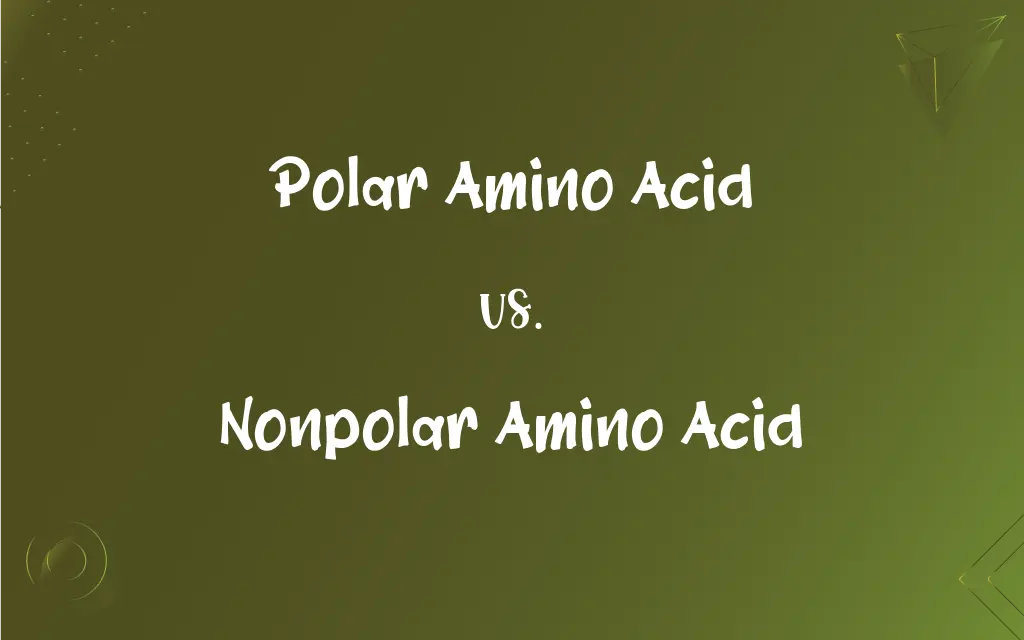Polar Amino Acid vs. Nonpolar Amino Acid: What's the Difference?
Edited by Aimie Carlson || By Janet White || Published on February 23, 2024
Polar amino acids contain side chains that can form hydrogen bonds due to their polarity, whereas nonpolar amino acids have side chains that are hydrophobic and cannot form hydrogen bonds.

Key Differences
Polar amino acids are characterized by their side chains that can form hydrogen bonds, making them hydrophilic. This property allows them to interact well with water and other polar substances. On the other hand, nonpolar amino acids have side chains that are hydrophobic, meaning they repel water and do not form hydrogen bonds. This difference significantly affects how these amino acids interact within proteins and with their environment.
The side chains of polar amino acids often contain functional groups like hydroxyl, amide, or sulfhydryl, which can participate in chemical reactions. These reactive groups make polar amino acids versatile in protein structure and function. In contrast, nonpolar amino acids have side chains composed of hydrocarbons or simple carbon rings, making them less reactive and more suited to forming the hydrophobic cores of proteins.
In proteins, polar amino acids are frequently found on the surface due to their affinity for the aqueous environment. They play key roles in enzyme activity, substrate binding, and protein-protein interactions. Nonpolar amino acids, however, are typically found in the interior of proteins, stabilizing the protein structure through hydrophobic interactions.
Polar amino acids can be charged (positively or negatively) at physiological pH, which adds to their reactivity and ability to form ionic bonds. Nonpolar amino acids, lacking such charges, contribute to the structural integrity of proteins without participating in ionic interactions, influencing the overall shape and stability of the protein.
The solubility of polar amino acids in water is high due to their ability to form hydrogen bonds with water molecules. Conversely, nonpolar amino acids are less soluble in water but more soluble in nonpolar solvents, reflecting their hydrophobic nature and tendency to avoid aqueous environments.
ADVERTISEMENT
Comparison Chart
Solubility in Water
High due to ability to form hydrogen bonds
Low, prefers nonpolar solvents
Side Chain Composition
Contains functional groups like OH, NH2
Mostly hydrocarbons or carbon rings
Role in Protein Structure
Often on protein surface, hydrophilic
Forms hydrophobic core, inside proteins
Interaction with Water
Hydrophilic, forms hydrogen bonds
Hydrophobic, repels water
Charge at Physiological pH
Can be charged (positive or negative)
No charge, hydrophobic
ADVERTISEMENT
Polar Amino Acid and Nonpolar Amino Acid Definitions
Polar Amino Acid
They are typically found on the outer surfaces of proteins in aqueous environments.
Threonine, a polar amino acid, often participates in protein interactions.
Nonpolar Amino Acid
They lack charged side chains, making them less reactive in proteins.
Alanine, a nonpolar amino acid, is often involved in forming protein backbones.
Polar Amino Acid
Polar amino acids are essential for enzymatic functions and substrate binding.
Tyrosine, a polar amino acid, is vital in signal transduction pathways.
Nonpolar Amino Acid
These amino acids are typically soluble in nonpolar solvents, not water.
Valine, a nonpolar amino acid, stabilizes hydrophobic interactions in proteins.
Polar Amino Acid
These amino acids often contain reactive groups like hydroxyl or amide.
Asparagine, a polar amino acid, plays a crucial role in protein folding.
Nonpolar Amino Acid
Nonpolar amino acids contribute to the overall shape and stability of proteins.
Phenylalanine, a nonpolar amino acid, plays a key role in maintaining protein structure.
Polar Amino Acid
Polar amino acids have hydrophilic side chains capable of forming hydrogen bonds.
Serine, a polar amino acid, is often involved in enzyme active sites.
Nonpolar Amino Acid
Nonpolar amino acids have hydrophobic side chains that repel water.
Leucine, a nonpolar amino acid, contributes to protein structural integrity.
Polar Amino Acid
Polar amino acids can be charged, affecting their interactions in proteins.
Glutamic acid, a charged polar amino acid, contributes to protein stability.
Nonpolar Amino Acid
Nonpolar amino acids often form the interior of protein structures.
Isoleucine, a nonpolar amino acid, is frequently found in the core of proteins.
FAQs
Are nonpolar amino acids soluble in water?
No, nonpolar amino acids are not soluble in water but are soluble in nonpolar solvents.
What are polar amino acids?
Polar amino acids are those with side chains that can form hydrogen bonds and are hydrophilic.
What defines a nonpolar amino acid?
Nonpolar amino acids have hydrophobic side chains that do not form hydrogen bonds.
Can polar amino acids be charged?
Yes, some polar amino acids can be positively or negatively charged at physiological pH.
What role do nonpolar amino acids play in proteins?
Nonpolar amino acids typically form the hydrophobic core of proteins, contributing to structural stability.
Do polar amino acids participate in enzyme activity?
Yes, polar amino acids are crucial in enzyme activity and substrate binding.
How do nonpolar amino acids affect protein shape?
Nonpolar amino acids help determine the overall shape and stability of proteins by forming hydrophobic interactions.
Are all polar amino acids charged?
Not all; some polar amino acids are uncharged but still hydrophilic due to their ability to form hydrogen bonds.
What types of interactions do polar amino acids facilitate?
Polar amino acids facilitate hydrogen bonding and ionic interactions.
Where are polar amino acids typically found in proteins?
Polar amino acids are often found on the surface of proteins in aqueous environments.
What is the solubility characteristic of nonpolar amino acids in water?
Nonpolar amino acids have low solubility in water due to their hydrophobic nature.
Are polar amino acids essential for protein-protein interactions?
Yes, polar amino acids play a significant role in protein-protein interactions.
Are nonpolar amino acids reactive?
Nonpolar amino acids are less reactive compared to polar ones due to their lack of functional groups.
Can polar amino acids form ionic bonds?
Yes, charged polar amino acids can form ionic bonds.
How do nonpolar amino acids interact with other molecules?
Nonpolar amino acids mainly engage in hydrophobic interactions.
Do polar amino acids affect protein solubility?
Yes, the presence of polar amino acids can increase a protein's solubility in water.
What makes nonpolar amino acids different in terms of chemical reactivity?
The hydrophobic and non-reactive nature of their side chains makes nonpolar amino acids different in chemical reactivity.
What is the role of nonpolar amino acids in protein folding?
Nonpolar amino acids contribute to protein folding by driving hydrophobic core formation.
Do nonpolar amino acids have functional groups?
Nonpolar amino acids typically lack reactive functional groups, having mostly hydrocarbons or carbon rings.
How do polar amino acids influence protein structure?
Polar amino acids influence protein structure by forming hydrogen bonds and interacting with the aqueous environment.
About Author
Written by
Janet WhiteJanet White has been an esteemed writer and blogger for Difference Wiki. Holding a Master's degree in Science and Medical Journalism from the prestigious Boston University, she has consistently demonstrated her expertise and passion for her field. When she's not immersed in her work, Janet relishes her time exercising, delving into a good book, and cherishing moments with friends and family.
Edited by
Aimie CarlsonAimie Carlson, holding a master's degree in English literature, is a fervent English language enthusiast. She lends her writing talents to Difference Wiki, a prominent website that specializes in comparisons, offering readers insightful analyses that both captivate and inform.































































